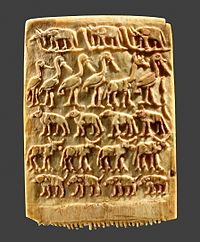Davis comb
| Davis comb | |
|---|---|
  The Davis ridge, double-sided view
|
|
| material | ivory |
| Dimensions | H. 5.5 cm; W. 3.9 cm; T. 0.5 cm; |
| origin | unknown (art trade) |
| time | Predynastic Period , Naqada III , around 3200-3100 BC Chr. |
| place | New York City , Metropolitan Museum of Art , 8/30/224 |
The Davis comb is an ornate comb made of ivory from the predynastic period ( Naqada III, around 3200-3100 BC) of Egyptian history . It was acquired in an art market by Theodore M. Davis at an unspecified time ; its location is unknown. After Davis' death in 1915, the comb came into the possession of the Metropolitan Museum of Art in New York City .
description
Only the handle of the comb remains, the prongs are lost. The height obtained is 5.5 cm, the width 3.9 cm and the thickness 0.5 cm. The material used was elephant tooth, which distinguishes the Davis comb from the many comparable pieces from the Negade period, which were mainly made from hippopotamus tooth.
The handle is decorated with rows of animals on both sides. Both sides have five rows, which are arranged bustrophedon . The first two rows are identical on both sides. At the top there are three elephants , each trampling two snakes ; however, this interpretation is not undisputed. Below is a row that begins with an erect snake and a saddle stork . Behind him are a giraffe , three more saddle storks and finally a heron or crane . The third row consists of three felids (probably lions ) on one side , the rearmost row of which is attacked by a dog . The other side shows four canids (maybe jackals ). In the fourth row are horn-bearers . A gazelle and three oryx antelopes are depicted on one side, and four cattle or wild bulls on the other . The fifth row shows four dogs or pigs , behind which a flower or a star follows on one side .
The Davis comb is one of a larger group of Negad period art objects on which rows of animals are depicted. At the moment, however, no other comb with a comparable decoration is known. The items with rows of animals include the handle of a club ( Sayala club ) and several knife handles (e.g. Brooklyn knife handle , Carnavon knife handle , Pitt Rivers knife handle , Gebel-el-Tarif knife , knife from Gebel el- Arak ).
literature
- The Metropolitan Museum of Art. Vol. 1. Egypt and the Ancient Near East. The Metropolitan Museum of Art, New York 1987, ISBN 978-0-87099-413-5 , p. 12 ( online ).
- Dorothea Arnold : To Egyptian Bestiary. In: The Metropolitan Museum of Art Bulletin. Volume 52, Issue 4, 1995, p. 8 ( online ).
- Georges Bénédite : The Carnarvon Ivory (Continued). In: The Journal of Egyptian Archeology. Volume 5, Issue 4, October 1918, pp. 225-241.
- Rainer Michael Boehmer : Oriental influences on decorated knife handles from predynastic Egypt. In: Archaeological Communications from Iran. New Series, Volume 7, 1974, pp. 15-40.
- Günter Dreyer : Motifs and dating of the decorated predynastic knife handles. In: Christiane Ziegler (ed.): L'art de l'Ancien Empire égyptien. Actes du colloque organisé au musée du Louvre par le Service culturel les 3 et 4 avril 1998 . La Documentation française: Musée du Louvre, Paris 1999, ISBN 2-11-004264-8 , pp. 195–226.
- Helene J. Kantor : The Final Phase of Predynastic Culture. Gerzean or Semainean (?) In: Journal of Near Eastern Studies . Volume 3, 1944, pp. 110-136.
Web links
- metmuseum.org: Hair Comb Decorated with Rows of Wild Animals